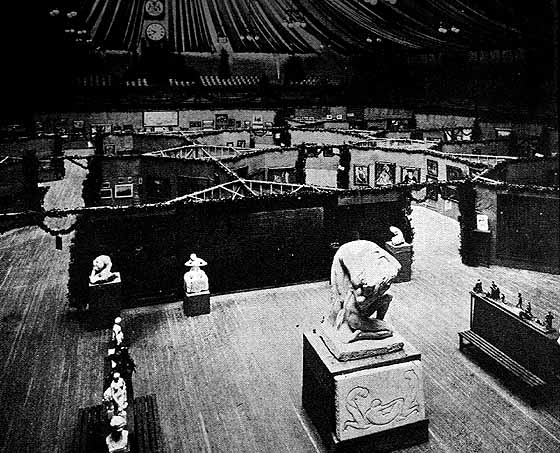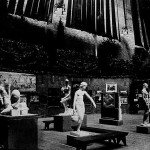
Can a single art exhibition alter a nation’s cultural consciousness? Could it usher in new appreciation, even new archetypes for how art is created and enjoyed?
In 2013, probably not. Contemporary culture is too fractured, entertainment too micro-targeted for such momentous impact. Individual exhibitions can be impactful, even transformative for a limited audience. But never again could one gallery show change how an entire people embrace the visual arts.
 That high-water mark was achieved almost exactly a century ago, with the February 17-March 15, 1913 International Exhibition of Modern Art at the 69th Regiment Armory on Lexington Avenue in New York City.
That high-water mark was achieved almost exactly a century ago, with the February 17-March 15, 1913 International Exhibition of Modern Art at the 69th Regiment Armory on Lexington Avenue in New York City.
National Guard armories were, once upon a time, popular gathering places for events of all kinds. Their vast interior spaces, usually under-utilized and available for rent during peacetime, were dedicated to musical concerts, boxing and wrestling matches, and yes, even art exhibitions, throughout the twentieth century.
But mention “the Armory Show” to any art historian, and they will know you can be referring to only one event. The Armory Show was the first major American showing of contemporary art, heavily featuring European luminaries such as Marcel Duchamp, Henri Matisse, and Pablo Picasso; but not ignoring American artists including James Whistler and Gifford Beal. It introduced American audiences, previously steeped mainly in realism and the American folk-art tradition, to the emerging styles of Cubism and Futurism.
The Armory Show was the creation of the then-newly formed Association of American Painters and Sculptors, members of which spent several months in 1912 touring Europe, meeting artists, collectors, and curators, and making arrangements to borrow works for the exhibition. When the show at last opened the following February, it featured more than 1,300 paintings, sculptures, and decorative works. After closing in March, smaller versions of the show (mostly omitting the work of American artists) were staged in Chicago and Boston.
Chicago and Boston.
The shows were an overwhelming success, and their impact and legacy were almost immediately recognized. Tributes and recreations have been mounted regularly over the decades, with notable versions occuring in 1944 in Cincinnati, and in 1958 at Amherst College. The 50th Anniversary show in Utica, New York in 1963 featured more than 300 works from the original.
Now, at the centennial of this seminal event, no less than three physical exhibitions and one extraordinary website are paying homage to the Armory Show. The Montclair Art Museum in Essex County, New Jersey is currently staging “The New Spirit: American Art in the Armory Show, 1913.” Later this year the New York Historical Society will be presenting “The Armory Show at 100.” And the Fountain Art Fair will be returning to the original Lexington Avenue Armory from March 8-March 10 for “At the Armory.”
Somewhat more accessible for most of us is the Smithsonian’s Archives of American Art, which has created the interactive 1913 Armory Show: The Story in Primary Sources. The website features a sliding timeline, displaying original documents and ephemera relevant to the conception, preparation, and staging of the show. It’s a fascinating glimpse into how any art exhibition might have been produced in the previous century, made all the more gripping by the enduring legacy of this one particular show.
Again, there will never be another show like the Armory Show. Never again will a single exhibition of art seize a country’s imagination. But our imaginations can be engaged, at least, through our collective memories of the Armory Show, and of the Armory Show’s continuing impact on American art appreciation.